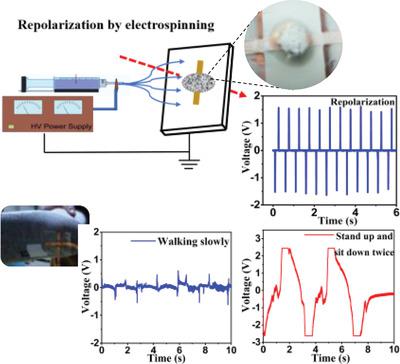当前位置:
X-MOL 学术
›
Macromol. Mater. Eng.
›
论文详情
Our official English website, www.x-mol.net, welcomes your
feedback! (Note: you will need to create a separate account there.)
Self‐Powered Flexible Sensor Based on the Graphene Modified P(VDF‐TrFE) Electrospun Fibers for Pressure Detection
Macromolecular Materials and Engineering ( IF 4.2 ) Pub Date : 2019-10-03 , DOI: 10.1002/mame.201900504 Ping Li 1, 2 , Libo Zhao 1, 2 , Zhuangde Jiang 1, 2 , Mingzhi Yu 1, 2 , Zhen Li 1, 2 , Xuejiao Li 1, 2
Macromolecular Materials and Engineering ( IF 4.2 ) Pub Date : 2019-10-03 , DOI: 10.1002/mame.201900504 Ping Li 1, 2 , Libo Zhao 1, 2 , Zhuangde Jiang 1, 2 , Mingzhi Yu 1, 2 , Zhen Li 1, 2 , Xuejiao Li 1, 2
Affiliation

|
Polymer P(VDF‐TrFE) has been extensively applied in modern flexible electronics, such as nanogenerators and pressure sensors. In this study, a repolarization method is proposed to exploit the piezoelectric properties of the P(VDF‐TrFE) electrospinning film modified by the reduced graphene oxide (rGO). Then, the repolarized composite film is applied as the self‐powered flexible pressure sensor. Notably, the piezoelectric output voltage and current of the repolarized composite film are up to 1.5 V and 0.125 µA, respectively. Typically, the piezoelectric voltage of the composite film is three times as high as that of the pure spinning film. Meanwhile, this composite film also exhibits piezoresistive effect, which is ascribed to the 3D network structure of the electrospun nanofibers. In addition, the highest piezoresistive sensitivity of the pressure sensor is 0.072 kPa−1. To sum up, the pressure sensor fabricated in this study allows to simultaneously detect the static and dynamic pressure loads, which thereby has great application potentials in electronic skins (e‐skins) for human motion monitoring, such as motion state and finger bending.
中文翻译:

基于石墨烯修饰的P(VDF-TrFE)电纺纤维的自供电柔性传感器用于压力检测
聚合物P(VDF-TrFE)已被广泛应用于现代柔性电子产品,例如纳米发电机和压力传感器。在这项研究中,提出了一种复极化方法,以利用被还原的氧化石墨烯(rGO)改性的P(VDF-TrFE)电纺膜的压电特性。然后,将重新极化的复合膜用作自供电的柔性压力传感器。值得注意的是,再极化复合膜的压电输出电压和电流分别高达1.5 V和0.125 µA。通常,复合膜的压电电压是纯纺丝膜的压电电压的三倍。同时,该复合膜还表现出压阻效应,这归因于电纺纳米纤维的3D网络结构。此外,-1。综上所述,本研究中制造的压力传感器可以同时检测静态和动态压力负载,因此在电子皮肤(e-skin)中具有很大的应用潜力,可用于人体运动监测,例如运动状态和手指弯曲。
更新日期:2019-12-05
中文翻译:

基于石墨烯修饰的P(VDF-TrFE)电纺纤维的自供电柔性传感器用于压力检测
聚合物P(VDF-TrFE)已被广泛应用于现代柔性电子产品,例如纳米发电机和压力传感器。在这项研究中,提出了一种复极化方法,以利用被还原的氧化石墨烯(rGO)改性的P(VDF-TrFE)电纺膜的压电特性。然后,将重新极化的复合膜用作自供电的柔性压力传感器。值得注意的是,再极化复合膜的压电输出电压和电流分别高达1.5 V和0.125 µA。通常,复合膜的压电电压是纯纺丝膜的压电电压的三倍。同时,该复合膜还表现出压阻效应,这归因于电纺纳米纤维的3D网络结构。此外,-1。综上所述,本研究中制造的压力传感器可以同时检测静态和动态压力负载,因此在电子皮肤(e-skin)中具有很大的应用潜力,可用于人体运动监测,例如运动状态和手指弯曲。










































 京公网安备 11010802027423号
京公网安备 11010802027423号